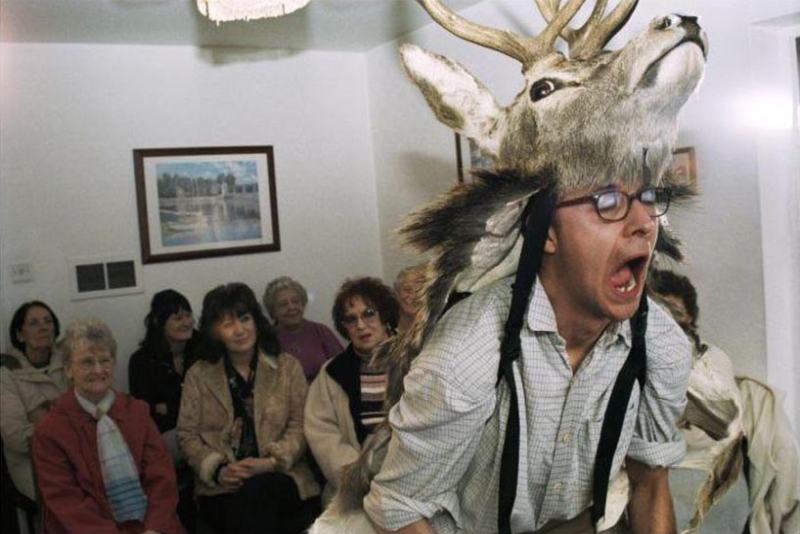The third and final slice of a series from composer Neil Luck, on performance, politics, and the possibilities of the colloquial.
It’s problematic, being an artist right now. Natural ambitions towards international ‘expansion’ often feel at odds with an increasing public and political sway towards reestablishing borders and divisions.
I want to draw attention to artworks that represent fascinating models of a kind of ‘radical colloquialism’. Perhaps in explicitly local forms and languages we can find models of art making that begin to connect global audiences in surprising ways.
Marcus Coates
In contrast to the previous two articles, I want to flip the perspective here and focus on an artist who literally and figuratively travels to far-flung places, gathering knowledge and experiences to address localised, community orientated, often deeply personal issues.
I first encountered the work of Marcus Coates in 2010 through his astonishing exhibition at Milton Keynes Gallery, Psychopomp. That title left a strong impression; it refers to a figure present in many cultures, religions and mythologies who guides individuals to the underworld (think Charon, a Banshee, or Dante’s Virgil). It also seemed to sum up Coates’ aesthetic – a panoply of hysterical, wild, often alarming ideas, images and sounds refracted through a somehow very British sense of ceremony and decorum.
Coates works in a wide range of mediums, but many of his projects feature performance and sound at their heart. Indeed, The Trip (2011) is a video work in which almost nothing visual happens at all (you can find the full work here). Commissioned by the Serpentine Gallery and St. John’s Hospice, the work foregrounds a conversation between Coates and a patient nearing the end of life.
Displaying a static shot looking out of a hospital window, we hear him telling the artist off-camera that his greatest regret was never visiting the Amazon, where he would have liked to have posed several questions to its native inhabitants.

Coates undertakes this epic journey on the patient’s behalf, travelling to the rainforest to ask these questions to indigenous tribe members. Rather than documenting the journey in photos or videos, however, we hear Coates in the second half of the film relaying his experiences and findings back to the patient as memories, and in the final minutes playing a short audio recording of a tribesman singing.
The beauty and significance of the The Trip is not in its exotic faraway locations, but in the bringing back of esoteric knowledge and experiences. By relying on recollections and sound alone the patient’s (and the viewer’s) imagination is activated in a way often stifled by visual stimuli. As the patient poignantly remarks: “with your interpretation one has been able to experience… not completely as if one was doing it oneself… but it’s got very near it”.
Journey to the Lower World
In several others works, Coates takes metaphysically distant journeys whilst adopting the role of an archetypal Shaman (a further manifestation of the Psychopomp). In Journey to the Lower World (2004), for instance, we encounter the artist holding forth in a tiny living room, in a Liverpool housing estate scheduled for demolition. On behalf of a small audience of residents, Coates (sporting a dramatic taxidermic reindeer head and hide) undergoes an elaborate ritual in order to visit the “lower world” – a realm where he is able to ask animal spirits a pair of questions posed by those threatened with eviction.
What could have been a problematic adaptation of various global indigenous cultures, however, is treated utterly sincerely, and with a knowing and bathetic hokiness. The space is “prepared” with a vacuum cleaner, the sound of ritualistic drumming is played over a CD ghettoblaster, Coates’ own performance foregrounds a repertoire of awkward, raw animalistic yelps, clicks, and groans.
Initially the audience react with laughter, surprise, and nervous banter. After ten minutes, however, the same faces are focused, intent, and clearly moved by the artist’s subsequent retelling of his allegorical encounter with a mystical sparrow-hawk.
]
What Coates’ journeying offers is an expanded, and deeper worldview suggesting connections, solutions, and meanings where they weren’t perceived before. He tackles almost impossible problems and situations that require radical perspectives, and so by turns radical actions. Through performance, sound, and image Marcus Coates begins to make spiritual, global, and local ecologies vibrate together, to occupy the same space at the same time. This manifests as strange, beautiful, interspecies ways of seeing, hearing, and being in the world that feel (to me at least) more necessary than ever
Neil Luck is a composer, performer, and director based in London. His music engages the physical and fallible nature of live performance in multimedia contexts, and attempts to frame the act of music making itself as something strange, useful, or spectacular in and of itself. He runs the performance group ARCO.

